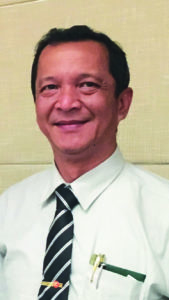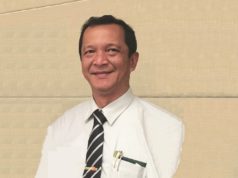
Collaboration, academic support, and hands-on training provided by the Singapore General Hospital, Singapore, have driven the small interventional radiology (IR) community of Myanmar to the international stage. As one of the organising members of the Asia-Pacific Society of Cardiovascular and Interventional Radiology (APSCVIR), the group of interventional radiologists in Myanmar have been working more closely with members of the Society of Interventional Radiology (SIR) and the Cardiovascular and Interventional Radiological Society of Europe (CIRSE) to promote the specialty locally. Despite huge strides over the last decade in the number and complexity of IR cases being undertaken in the country, Myanmar faces several challenges, which Kyaw Zay Ya (an interventional radiologist based in Nyaung, Myanmar; full interview from CIRSE 2019 here) summarised as the “three Ms: man, money, and materials”.
Due to a cancelled flight, Bien Soo Tan (Singapore General Hospital, Singapore) addressed delegates on behalf of Ya, speaking at the 2019 annual meeting of the Cardiovascular and Interventional Radiological Society of Europe (CIRSE; 7–11 September, Barcelona, Spain).
Myanmar is a large country in South East Asia with a population of 54 million, and a land area of 676,575km2. In the late 1970s and early 1980s, a conventional angiography system with serial changer was installed for diagnostic purposes in Yangon General Hospital (Yangon, Myanmar). By the end of the 1980s, digital subtraction angiography (DSA) was possible in the country, and some vascular and non-vascular interventional radiology (IR) procedures were performed in the early 1990s, though there was no proper training for interventionalists.
“At that time,” Tan said, “there were several very senior radiologists in Myanmar who were trained in Europe, in particular the UK, and when they went back [to Myanmar], they did introduce some of these procedures, […] primarily angiography and even chemoembolization.”
Following this informal introduction of IR to the country, Tan’s own institution, the Singapore General Hospital, provided IR training to radiologists in Myanmar. This paved the way for the first two Myanmarese interventional radiologists to gradually start working in their home country in the early 2000s, with “very limited consumables available to them”.
Since then, IR has grown steadily in Myanmar. From 2008, interventional radiologists at Singapore General Hospital have trained one or two candidates, and have provided some of the required consumables. These are often consumables in Singapore which are close to expiry, as Tan explained: “They are not freely available; the distributors are not really bringing in these consumables, because there is not much volume in Myanmar itself.”
Today, Myanmar is one of the organising members of APSCVIR, and Tan told delegates that, increasingly, Myanmar is in contact with SIR, based in the USA, and CIRSE, in Europe. Indeed, earlier in the session, APSCVIR president Andrew Holden (Auckland, New Zealand) had praised the “very active outreach programme” in Myanmar; when CIRSE president, Robert Morgan (London, UK) visited the country in January 2019 to take part in said programme. Of this experience, he said: “I was struck firstly by how large Myanmar is as a country, and secondly by how beautiful it is as a country. The people are all very friendly, so I would certainly recommend anyone who wishes to go and visit to do so. I was impressed by the set-up in the hospitals there. I may have had pre-conceived ideas that things would be relatively primitive, but they were not, in fact; there were pretty good facilities in each of the hospitals I went to in Yangon and Mandalay. […] I think it was a very good venture for CIRSE to be involved in, and I am pleased that Afshin Gangi [CIRSE president since September 2019] will continue this in January next year.”
Speaking about convincing hospitals and governments to support the establishment and progression of IR, Tan commented: “For us [in Singapore], I think some of these arguments have been ongoing within our own institutions and national systems, but you can imagine that in Myanmar, the conversations are [at a] much earlier [stage], [as they] try to argue why IR should be supported.” On his presentation slide, Ya had outlined shorter hospital stays, money saving, reduction in transfusion requirements, better quality of life for patients, faster recovery times, and high intensity local treatments as convincing arguments supporting the development of an IR department.
“These advantages are all very clear to us”, Tan acknowledged to the CIRSE audience, while in Myanmar, he explained how the country’s interventional radiologists “have to start the conversation and lobby the hospital administrators, the ministry, to get more training, more equipment.”
Regaling the CIRSE audience with a personal anecdote, Tan shared: “I think one very telling story I have—I have visited Myanmar quite regularly for ten years now—when I went in 2009, they had an angiography unit installed in Yangon General Hospital that was quite new, I think it was two to three years old, but the tube had blown. So in 2009, there was no angiography available in Yangon General Hospital, which is the largest public hospital in the whole of Myanmar. When I went back over the next three to four years, they still had not got the money to buy the tube. Only about six or seven years later did they decide to junk the machine, and they got a new machine in. So these are the challenges that they are facing.”
Despite the difficulties with procurement, a “whole spectrum” of IR procedures are currently being conducted in Myanmar, tailored to the disease distribution seen in the country. There are six public centres and six private centres offering IR services. Between 2015 and 2019, in public centres across Myanmar, there have been, each year, on average: 612 transarterial chemoembolization (TACE) procedures (“one of the main treatments for inoperable HCC”, Tan told the audience, “they do not have the other modalities available, like Y90”), 721 guided biopsies, 67 percutaneous transhepatic biliary drainages (PTBD), 44 angioplasties, 21 intracranial arteriovenous malformations (AVM) treated, and three abdominal aortic aneurysms (AAA) stented. In the private sector, there is on average 352 TACE procedures, 35 guided biopsies, 23 PTBDs, and 18 angioplasties performed each year.
Remarking on the 21 intracranial AVMs treated in the public centre, Tan observed: “Very little neurointervention for such a huge population”.
These procedures have all been conducted by the small group of interventional radiologists working in the country. Modern-day Myanmar has 15 practicing interventional radiologists, trained at several institutions across Asia, including Singapore, Thailand, the Republic of Korea, Japan, and India. There are two senior radiologists in the country with interventional training who have retired from public practice, but still work in the private sector. Twenty Myanmarese trainees have received local training, and are preparing to move abroad to “gain more intense exposure”, in Tan’s words, to the discipline.
In addition to procurement difficulties and the low number of interventional radiologists, Myanmar faces other challenges in being able to offer IR services to its 54 million inhabitants. Access to adequate training stymies the discipline’s development. Furthermore, awareness of IR among interventionalists’ clinical colleagues is low, according to Tan, “and therefore the referral system is not robust.”
However, he then said that the healthcare system is starting to invest in IR. “They [the Myanmarese healthcare system] are now starting to be vendors and distributors, gaining interest, but unfortunately, a lot of the interest is focused on cardiology, because that is where the money comes in, and less on IR.”
Ambitions for a more developed IR programme in Myanmar
Enumerating Ya’s aspirations for the development of IR in Myanmar, Tan listed the following:
- To have vascular interventional radiology (VIR) services in all tertiary hospitals
- To train more interventional radiologists
- To establish a 24-hour VIR service, especially for emergency cases
- To build up VIR clinics in all tertiary hospitals
- To train neuro-interventionalists
- To establish VIR sub-units in the radiology department of every teaching hospital
- To conduct up-to-date research within the specialty











